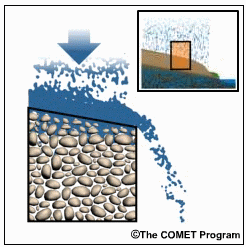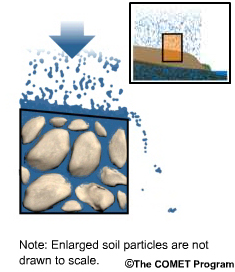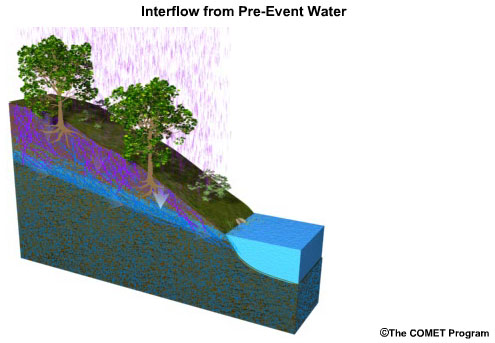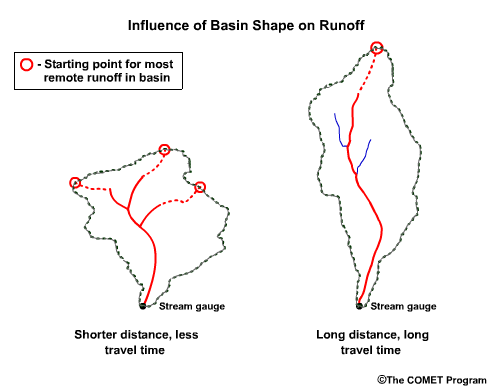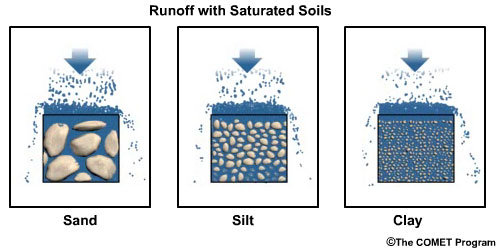Print Version
Overview of Runoff

An accurate estimate of runoff from rain and snowmelt is one of the most important elements of the flood forecast process.
In this section we will define runoff and introduce some important terms used when discussing the rainfall-runoff process. We will discuss the runoff from both rain and snowmelt and how it relates to the overall hydrologic forecasting process.
In this section you will learn to:
- Define rainfall runoff
- Identify the general movement of water both on the surface and in the ground
- Recognize the different terms associated with groundwater and runoff
- Understand the relationship between precipitation/snowmelt rate and infiltration
Runoff Defined

Runoff is often defined as the portion of rainfall, snowmelt, and/or irrigation water that runs over the soil surface toward the stream rather than infiltrating into the soil. It is sometimes called surface runoff.
For some purposes however, the definition of runoff also includes water which makes its way relatively quickly to the stream channel just below the surface. This is sometimes called interflow or subsurface runoff, and together with surface runoff makes up the volume of water that hydrologists generally refer to as runoff.
Role in Flood Prediction

The main reason for studying the runoff process is to get an estimate of the amount of water that makes its way quickly to the stream channel. Runoff is the most important component of flood prediction and can consist of either rainwater or water from melting ice and snow. Watershed conditions will impact the proportion of rain or snow that becomes runoff. Once we know the amount of water expected to become runoff, other tools such as the unit hydrograph can assist us with estimating the resulting discharge in the stream.
Soil Water Processes
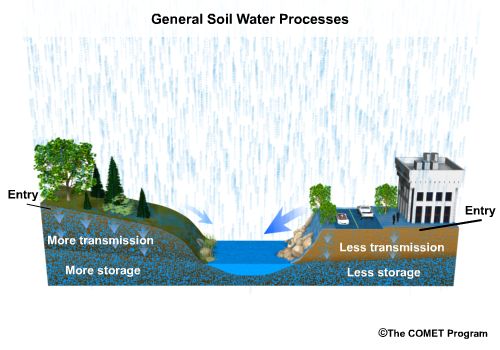
There are three physical processes for the movement of soil water: entry, transmission, and storage. Entry, also known as infiltration, occurs at the water-ground surface boundary. Transmission is the vertical and horizontal percolation that can occur throughout the entire depth of the soil layer. Storage can occur throughout the soil profile and is manifested as increased soil moisture.
Environmental conditions that affect these three processes are broadly broken down into two major categories: natural influences and human activity influences. Natural processes can have a variety of influences, but human activity typically results in less water entering the soil profile and thus more runoff at the ground surface.
General Runoff Terms
There are a number of terms commonly used to describe runoff processes. Let's briefly introduce some of these terms which will be covered in more detail in later sections of this module.
Basin, drainage basin, or watershed, are all terms used to describe the area contributing to the runoff. The runoff in a basin generally begins at the drainage divide that marks the perimeter of the basin. All runoff within a basin drains to a single point at the outlet of that basin.

Baseflow, or base runoff, is the long-term supply of water that keeps at least some water in the stream even during extended dry periods. Baseflow comes from water that percolated down into deep storage.
Infiltration is the downward movement of water through the soil surface. While it is often used interchangeably with percolation, percolation actually refers to movement of water within soil, and infiltration specifically refers just to the process of water entering a soil surface.
Surface runoff is the movement of water across the soil surface toward the stream channel.
Interflow is the relatively rapid movement of water below the soil surface toward the stream channel, typically within 72 hours of when water infiltrates the surface. This process is more likely in areas with deep soil.
Runoff, sometimes called quick response runoff, can refer to surface runoff only, but sometimes it is the combination of surface runoff plus interflow. Thus, it typically represents the movement of water to the stream channel that is not part of baseflow.
Infiltration Terms
Infiltration rate is the amount of water able to enter the soil in a specified time period. It is expressed as depth per time; for example, 10 millimeters per hour.
Infiltration capacity is the upper limit of infiltration rate. It includes surface infiltration and percolation and is expressed in depth per time; for example, 15 millimeters per hour.
If precipitation rate is less than or equal to infiltration capacity, no surface runoff occurs.
If precipitation rate is greater than infiltration capacity, surface runoff occurs.
Surface runoff equals rainfall or snowmelt rate minus infiltration capacity.
For example, if our rainfall rate increases to 25 millimeters per hour but the infiltration capacity remains at 15 millimeters per hour, then the rainfall rate is 10 millimeters per hour greater than the infiltration capacity. The 10 millimeters per hour that does not infiltrate becomes surface runoff.
Review Questions
Question 1
Simply stated, runoff is the portion of rain, snowmelt or irrigation water that makes its way quickly to the stream _____. (Choose the best answer)
The correct answer is b.
Question 2
When the rainfall rate is equal to the infiltration capacity, _____. (Choose all that apply.)
The correct answers are a and d.
Paths to Runoff
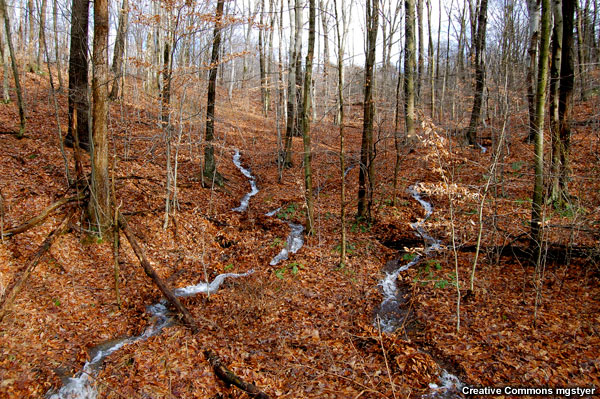
In this section we will describe the paths that water can take to the basin outlet. We will look at details about surface runoff, interflow, and pre-event water. We will also consider influences of climate, geography, and pre-event moisture.
In this section you will learn to:
- Identify the different types of runoff that occur both at and below the surface
- Recognize the influence of surface and soil properties that influence surface runoff
- Understand the soil properties that influence subsurface runoff, or interflow
- Anticipate the types of runoff you may expect in your area given the rainfall/snowmelt rate and the soil properties
Surface Runoff

There are two types of surface runoff that occur during rainfall or snowmelt.
Infiltration excess overland flow occurs with soil that is not saturated. In fact, the soil can be quite dry, but soil properties or land cover do not allow for infiltration to keep up with high rainfall or snowmelt rates.
Saturation excess overland flow occurs when the soil becomes saturated and there is no longer any space for water to infiltrate. This can occur even with soil that would typically allow for large amounts of infiltration in sub-saturated conditions.
Infiltration Excess Flow
Infiltration excess occurs when the rate of rainfall or snowmelt is greater than the infiltration capacity. The water that cannot infiltrate becomes surface runoff.
For example, if the infiltration capacity is 15 millimeters per hour and the rainfall rate is 25 millimeters per hour, then the rainfall rate exceeds the infiltration capacity by 10 millimeters per hour. That 10 millimeters per hour becomes infiltration excess overland flow, even if the underlying soil is dry.
Infiltration excess is most commonly observed with short-duration intense rainfall. It also occurs most often in areas with high clay content or where the surface has been altered by soil compaction, urbanization, or fire.
Infiltration excess overland flow is sometimes called Hortonian flow.
Saturation Excess Flow
Saturation excess occurs when the soil layers have become saturated and no further water can infiltrate.
It is most common with long-duration, gentle-to-moderate rainfall, or with the latter of successive precipitation and or snowmelt events.
For example, consider a storm that produces a steady rainfall rate of 10 millimeters per hour for four hours. After three hours of infiltration the soil becomes saturated. In the fourth hour, the 10 mm/hr rainfall rate cannot infiltrate the saturated soil and becomes saturation excess overland flow.

Saturation excess overland flow can occur anywhere the soil is wet. It is most common in humid climates with gently sloped or flat basins. Here we see a field where the soil can typically absorb a large amount of water. The standing water in relatively light rainfall suggests that soil saturation is preventing further infiltration of rainwater. Saturation excess overland flow is the result.
Interflow

Interflow, also known as subsurface runoff is relatively rapid flow toward the stream channel that occurs below the surface. It occurs more rapidly than baseflow, but typically more slowly than surface runoff. In some cases interflow may be as important as surface runoff for forecasting rapid rises in the stream channel. In fact, in regions with high infiltration rates and steep terrain, interflow may be the dominant process by which streams react quickly to rainfall or snowmelt.
This process is most likely to occur in humid, deep-soil areas. However, significant interflow contribution may occur in thin-soiled regions when there is an impermeable layer such as bedrock beneath the more permeable surface soil layer.
Transmissivity Feedback
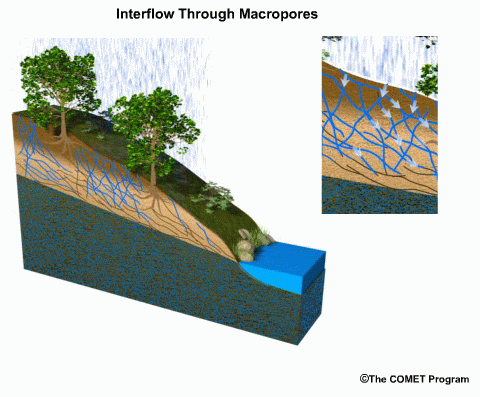
One runoff process that contributes to interflow is transmissivity feedback. This occurs when a network of macropores is activated following rapid infiltration.
Macropores and natural pipes are void spaces in the soil that provide preferential pathways for water to move downslope. Decayed plant roots, burrowing insects and animals, and chemical reactions between water and soil minerals are a few ways that macropores form.
Macropore networks are more likely in deep-soiled areas with considerable organic materials. Thus, humid climates are more likely to have substantial interflow through macropore networks.
Soil-Bedrock Interface
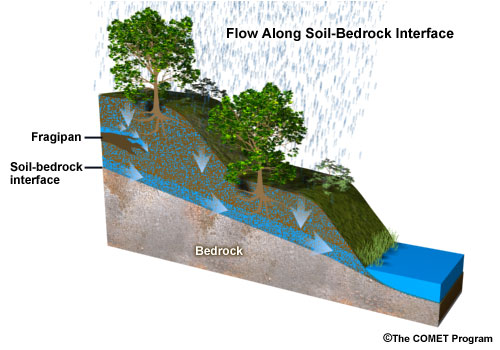
The presence of a soil-bedrock interface enhances interflow. The soil-bedrock interface typically occurs in steep terrain where the soil layer is considerably more permeable than the underlying bedrock. Rainwater or snowmelt infiltrates rapidly to the bedrock interface and then moves rapidly downslope along the interface.
Sometimes a feature called a fragipan exists. A fragipan layer has low permeability, like rock or clay, and may also serve to focus the lateral subsurface flow. Fragipan features can exist at relatively shallow depths and play an important role in enhancing both interflow and even surface runoff after the soil layers above the fragipan are saturated.
Groundwater Ridging
Groundwater ridging is yet another mechanism that contributes to runoff.
Groundwater ridging is a process that occurs in sloped drainage basins where the water table is much closer to the surface near the stream channel than it is further away from the stream.
Rainwater or snowmelt reaches the groundwater level near the stream channel more quickly than it does further up the hill away from the stream. The water table begins to rise near the stream channel more quickly than it does further away, creating a groundwater ridge close to the stream. The gradient between the groundwater ridge and the stream channel results in more rapid interflow to the stream.
In some cases the groundwater ridge can reach the soil surface and contribute to surface runoff through saturation excess overland flow.
Pre-Event Water
Some of the interflow that quickly finds its way to the stream is not necessarily from the current rainfall. In these cases there is considerable water already in the soil layers that gets displaced as new water infiltrates. The water that appears in the stream immediately following a rainfall or rapid snowmelt period may be from previous precipitation events, or pre-event water. In humid climates, studies have shown that pre-event water is often the greatest contributor to rapid rises in stream level.
Review Questions
Question 1
Which type of surface runoff is most likely with an intense 30-minute rainfall? (Choose the best answer.)
The correct answer is b.
Question 2
Which type of surface runoff is most likely with 48 hours of gentle steady rainfall in a forest? (Choose the best answer.)
The correct answer is a.
Question 3
Which type of surface runoff is most likely to occur in a flat, densely vegetated area? (Choose the best answer.)
The correct answer is a.
Question 4
Which type of surface runoff is most likely to occur in an urban area? (Choose the best answer.)
The correct answer is b.
Question 5
Water that exists prior to a significant rainfall event may become runoff as "pre-event water" but never amounts to a major proportion of the runoff. (True or False)
The correct answer is b.
Question 6
Interflow may be more important than surface runoff for generating a quick rise in streams located in _____. (Choose all that apply.)
The correct answers are b and c.
Question 7
Macropores _____ interflow by providing _____ for water to flow along. (Choose the best answer.)
The correct answer is b.
Question 8
Groundwater ridging decreases flow to the stream by blocking the interflow. (Choose the best answer.)
The correct answer is b.
Basin Properties


The physical properties of a drainage basin and its streams influence the amount and the timing of the runoff. These properties may come from natural and human factors.
In this section you will learn to:
- Recognize basin characteristics and how they impact runoff processes
- Explain the impact of urbanization on runoff characteristics
Contributing Area
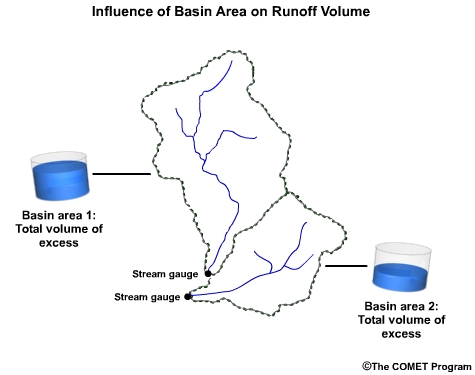
The size of the contributing area of the rainfall in a basin has a direct influence on the total volume of runoff that drains from that basin.
It probably comes as no surprise that when rain falls in a uniform manner over a larger basin and a smaller basin, the larger basin produces more runoff volume. All things being equal, a drainage area that is twice as large can generate twice as much runoff volume as its smaller counterpart.
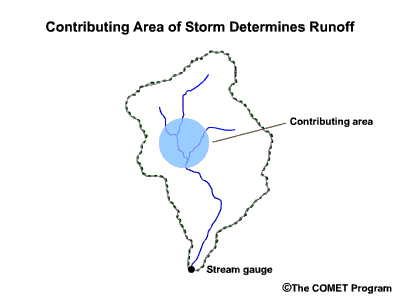
Of course many storms will cover only part of a basin. So for most situations, the runoff volume will be determined by the contributing area – that part of the basin covered by a storm – not the total size of a basin.
Basin Size
Likewise, consider two similarly shaped basins, with one larger than the other. Runoff traveling from the most upstream point of the larger basin will travel a longer path, and therefore take longer to reach the basin outlet than runoff traveling from the farthest point in the smaller basin. In addition, a single thunderstorm will likely only impact a portion of the large basin at any given time, but it may envelope the entire small basin.
Basin Shape
Basin shape also has an influence on magnitude and timing of the peak flow at the basin outlet.
Consider two basins of equal area where one is long and narrow, and the other is more round. Then consider runoff traveling from the farthest point in each basin to their respective outlets. The runoff in the more round basin will arrive more quickly at the basin outlet.
In addition, water from multiple locations in this basin is more likely to arrive at the outlet at the same time, resulting in a greater peak flow. By contrast, in a longer, narrower basin, water from multiple locations is less likely to arrive at the same time.
Stream Meanders
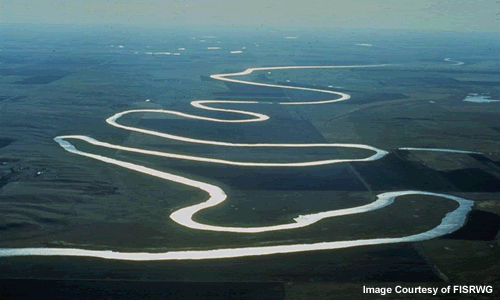
Meanders in the stream channel add to the distance that water must travel from upstream to downstream.
Consider a basin with meandering stream channels. If all of the meanders were straightened out, the distance that the water travels through the streams would decrease. This reduces the time it takes water to travel to the basin outlet. It also decreases the time over which water may infiltrate the ground through the bottom of the stream channel.
Meanders increase the travel time of runoff through the basin, and may reduce the overall runoff volume.
Additional Resources:
For more information on how landscape features such as river meanders are formed, consult the Fluvial Geomorphology Module from State University of New York College of Environmental Science and Forestry (SUNY ESF) http://www.fgmorph.com
Basin Slope
The slope of a basin affects the amount and the timing of runoff.
As the slope of the land increases several factors come into play. The first is that water contact to the surface is no longer perpendicular. With the land sloping, gravity no longer pulls the water directly into the ground, so more water is likely to become surface runoff.
Another factor is the movement of water across the land surface. As the ground becomes increasingly steep, water will move faster and will have less time in contact with the ground surface, reducing the time during which it could infiltrate.

Also important is the amount of sediment carried by flowing water. Erosion occurs when water removes sediment from the ground surface. Although it is dependent on soil type and ground cover, erosion generally increases with increasing slope. With higher amounts of sediment in the water, the surface pores in the soil which the water might otherwise enter, can become plugged, reducing infiltration.
In general, the steeper the hill slope and the steeper the drainage channels, the quicker the flow response and the higher the peak discharges.
Roughness
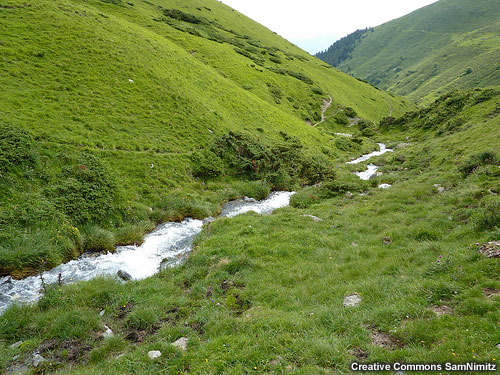

"Roughness" of a stream channel increases due to the presence of rocks, vegetation, and debris. Channelizing a stream by doing such things as removing vegetation and lining the stream bed with concrete will reduce the roughness. The roughness factor has a direct impact on how quickly the water will move in the channel and how high the peak stage will be. Manning's equation is often used in hydrology to account for the roughness factor.

The greater the roughness, the more turbulent the flow. More turbulent flow results in slower runoff and streamflow velocities. This allows more time for infiltration, and it also results in a broader flood wave with lower peak discharges than in rapid runoff situations.
Conversely, reducing channel roughness results in faster streamflow velocities and greater peak flows.
Additional Resources
Refer to the Streamflow Routing module, Section Four: Stream Properties and Manning's Equation for more information on Manning's Equation.
Stream Density
Stream density is the length of all channels within the basin divided by the area of the basin. Stream density is one of the most important characteristics for evaluating potential runoff.
A drainage basin with a large number of tributaries has a higher stream density than a basin with very few tributary streams. Higher stream density allows the landscape to drain more efficiently following a storm event. More efficient drainage means that water moves into streams and creeks faster, causing peak storm flows to be larger and to occur sooner.
A basin with a lower stream density usually indicates a deep, well-developed soil. In this case, water is more likely to infiltrate into the soil rather than become surface runoff and enter into the channel network.
Urbanization

Urbanization typically results in alterations to the natural ground surfaces and stream channels of a basin. Surface permeability, basin size, stream density, roughness, and channel length and slope can all be affected in a way that results in greater magnitude and speed of runoff.

In urban areas the greater coverage of pavement, buildings, and compacted soils prevents infiltration of rainfall and snowmelt compared to the natural ground surface. This can greatly increase the magnitude of runoff.

Urban features such as road embankments and berms can act to break down natural basins into smaller sub-basins. Smaller drainages react much more quickly to localized rainfall than larger basins.

Road grids, ditches, and storm sewer systems act as a network of tributaries and effectively increase stream density. Higher stream density results in more rapid runoff to the stream channels.
Compared to a natural stream bed, road surfaces, culverts, and storm sewers have smooth surfaces. This decrease in surface roughness allows runoff to move much more quickly to the main stream channels than it would in a more natural setting.

Streams in urban areas often have vegetation removed and are sometimes lined with concrete in a process called "channelization".� This also decreases roughness and causes water velocity to increase.
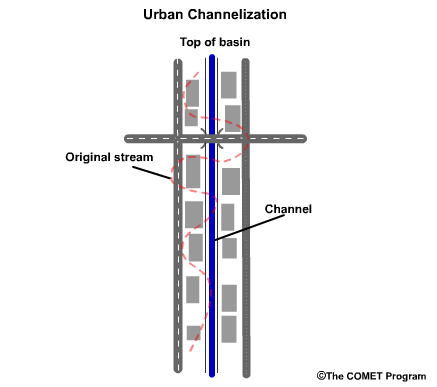
Sometimes as part of channelization urban streams are straightened by having meanders removed. This decreases the distance that water travels from the top to the bottom of the drainage basin. It also effectively increases the slope because the stream now experiences the same elevation drop but in a shorter distance. Decreasing the distance traveled and increasing slope will cause a more rapid flood response from the runoff.
Overall, an urban environment will result in faster runoff with more runoff reaching the streams than in a rural setting.
Review Questions
Question 1
Runoff is typically more efficient (i.e., it is faster and there may be more of it) when _____. (Choose all that apply.)
The correct answers are a and d.
Soil Properties
The soil characteristics in a basin have very strong influences on the character of the runoff. Not only must one consider the texture of soil, but also other important characteristics including surface cover, depth to impermeable layers, and alterations to the soil by either human activity or natural occurrences.
In this section you will learn to:
- Anticipate water movement and runoff given soil characteristics
- Identify important soil properties in your area
- Understand how both natural and human factors influence the behavior of water in the soil
Soil Texture Classification

Soil texture is classified according to particle size. Clay has the smallest particle and pore space size, followed by silt, and then by sand with the largest size particles. Soil texture is very important for anticipating the potential infiltration, movement, and storage of soil water.

The USDA soil triangle, based on the FAO soil triangle, is a reference tool that allows you to classify the soil based on the composition of its textures. For example, if you take a sample of soil and determine that it is roughly 40% silt, 40% sand, and 20% clay, then we can see that the soil classification is "Loam".
In-Depth:Soil Formation Process

Soil formation is the result of many natural processes. Soils typically develop such that the top layers show the greatest impact of vegetation and weathering (the O and A horizons) while the bottom layers (the C horizon) have the least influence from plants and weathering.
Climate is the most influential factor in soil formation as it directly affects the weathering of source material and is critical for biological activity.
Other natural influences of soil formation include vegetation type and patterns, the local geology, biological activity, mineral reactions, and watershed topography. These will affect how much rainfall or snowmelt will enter the soil and how it will move or get stored within the soil.
Soil Composition

Soil may be composed of one or more types of soil textures. When soil contains a large percentage of sand, infiltration and drainage of water occurs more quickly because of the larger pore space. Such soil can absorb relatively high rates of rainfall or snowmelt.

Soils with a relatively high percentage of clay will have smaller pore space and correspondingly lower infiltration rates. Therefore, soils dominated by clay are less capable of absorbing high rainfall rates.

Silt has a particle size between sand and clay. Soils with a high percentage of silt will have higher infiltration and drainage rates than clay, but not as high as sand.
Consequently, clay soils may result in greater surface runoff than sandy or silty soil during intense rainfall or rapid snowmelt. Sandy soil will generally produce the least surface runoff.
Soil texture information can assist with anticipating potential water storage and runoff. Keep in mind, of course, that it is still important to consider specifics of the situation such as soil moisture content and the rate of rainfall or snowmelt.
For example, if the soil is saturated as shown here, surface runoff will occur regardless of the soil texture.

Although it may seem counter-intuitive, the small pore spaces of clay add up to more total void space than the fewer number of large pore spaces in sand. Consequently, in light rain or slow snowmelt, clay may be able to hold more water than sand.
However, water drains from clay soil more slowly than from sandy soils. So in successive rain events, clay soils may remain saturated between storms and therefore produce more runoff in the later rain events.
Soil Profile
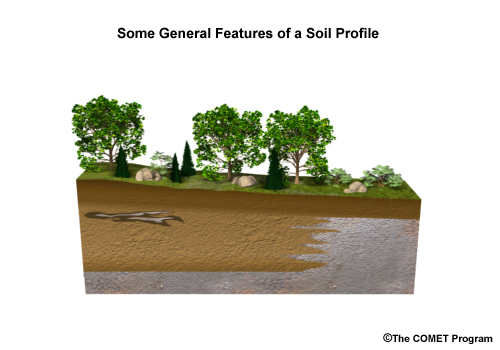
The soil profile provides information about the depth to bedrock as well as discontinuities in soil characteristics. Discontinuities include, among other things, vertical changes in soil properties and permeability.
Depth to bedrock can vary widely across even small areas. In river valleys with rich soil, the depth to bedrock may be at least 200 centimeters. By contrast, soil depth in other areas, such as mountainous regions, can be less than 25 centimeters.

In general, areas with greater soil depth will have greater capacity to absorb and store water. These areas will likely have more interflow as well. By contrast, shallow soil areas typically saturate faster and produce more runoff given the same soil and rainfall conditions.

Another important characteristic of the soil profile is whether there are impermeable or low-permeable layers within the profile (also known as a fragipan). For example, consider a low-permeable layer of clay and rock beneath a surface layer of sandy soil. Rainfall or snowmelt in this area may rapidly infiltrate into the top sand layer, but only very slowly percolate through the more impermeable layer in the profile. This can result in both enhanced runoff and interflow in this area. Some areas may also contain impermeable mineral layers, such as calcium carbonate deposits.

Finally, biologic and chemical activity in the soil can leave macropores. Recall that these natural pipes and void spaces enhance both the speed and the volume of water that can move vertically and horizontally through the soil profile.

Surface Properties

Soil surface properties can be the most important influence on runoff in some areas. If water is unable to infiltrate the soil surface, the characteristics of the soil profile below become unimportant. Impermeable surface materials, soil compaction, deforestation, and fire are factors that affect infiltration into the soil profile.
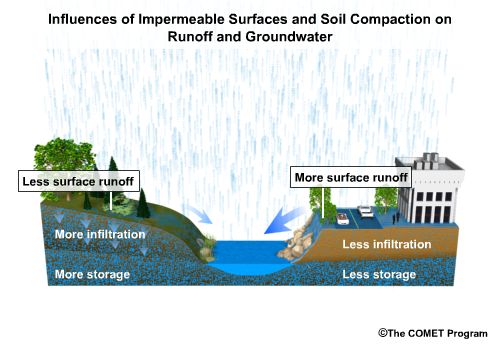
Covering ground surfaces with impermeable materials such as concrete and asphalt means less water can infiltrate. In addition, as soil becomes more compacted, the infiltration, percolation, and soil moisture storage all decrease. In general, human activity results in less infiltration, less storage, and greater surface runoff.

Deforestation can have an impact on infiltration and runoff. Without plant matter on the surface, water will move more quickly. This means water will have less time to infiltrate the soil. In addition, runoff from deforested areas is likely to contain more sediment. The sediment load can take up space in the stream channel that would otherwise be available for increased flow. Thus, deforested areas are more likely to result in enhanced runoff with large sediment loading into the stream channels.

Fires are a type of deforestation that can have more severe consequences on subsequent runoff. In addition to the typical deforestation problems, fires can alter the soil surface and make it temporarily hydrophobic, that is, unable to absorb water. This is especially noted in pine forest areas because the oils and resins from the trees vaporize and get infused into the soil. This creates a hydrophobic layer at or near the surface. The severity of runoff and sediment loading can often be seen by the scour on the tree trunks and the alluvial deposits left after the floodwater passes.
Review Questions
Question 1
Compared to sandy soils, clay soils are more likely to _____. (Choose all that apply.)
The correct answers are b and c.
Question 2
Infiltration excess overland flow is more likely during intense rainfall with _____. (Choose the best answer.)
The correct answer is a.
Question 3
Saturation of the soil profile occurs more quickly with _____. (Choose all that apply.)
The correct answers are a and c.
Question 4
Deforestation does not generally result in _____. (Choose the best answer.)
The correct answer is d.
Modeling Concepts
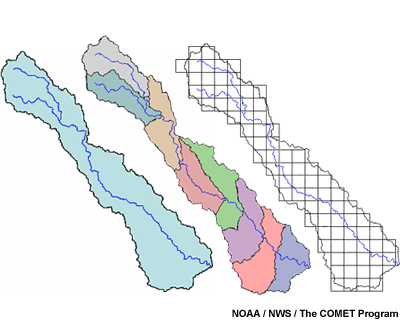
Various models from simple to complex have been developed for analyzing and predicting factors involved in runoff. The choice of a specific model depends on the type of information required and how the results are to be applied.
The number and types of assumptions within a model, the kinds of data needed, and the level of complexity are important factors when deciding which model to use.
In this section you will:
- Understand the basic concepts in runoff modeling
- Recognize why complex versus simple models are used
- Describe how a lumped model works
- Describe how a semi-distributed model works
- Describe how a distributed model works and the potential advantages as well as limitations
- Discover some popular examples of each type of model
Simple Modeling Concepts
At a very basic level, a simple rainfall runoff model could just compute the amount of rain running off a hard surface. An example would be if we looked at a paved parking lot covered with concrete or asphalt. Since no bare ground areas are present, infiltration would not take place. The amount of runoff from the parking lot would be about equal to the amount of rain that fell. Or, stated another way, the input would simply be rainfall and the output would be the runoff.
Rational Method

One of the simplest hydrologic situations to model is the peak runoff from a small area (less than about 80 hectares). The Rational method estimates only the peak flow using rainfall intensity, area, and a land use factor. Note that using this method, there is no timing associated with the peak flow.
The equation is:
Peak Runoff = C*I*A where:
- C is a unitless, land-use runoff coefficient
- I is the rainfall intensity, usually in mm hr-1
- A is the area, usually in hectares.
- The product would need to be multplied by a conversion factor of 0.00278, for the result to be in the common unit of cubic meters per second
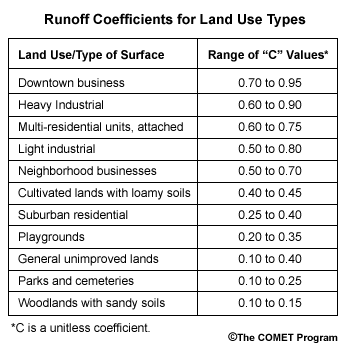
The value of C is found by using a table listing land use types.
The Rational method is used for computing peak runoff from small areas such as parking lots, crop lands, or public parks. It is primarily used in small basins where the coverage of impermeable surfaces is important.
This method provides no robust means of accounting for infiltration.
Complex Models

While simple hydrologic models are limited by assumptions and calculations, more complex models allow us to better approximate different parts of the hydrologic cycle. We can see from this diagram that a hydrologic model may take into account a complex array of natural and human-influenced factors.
In this model we see the input and movement of water through an idealized hydrologic system.
Lumped Modeling
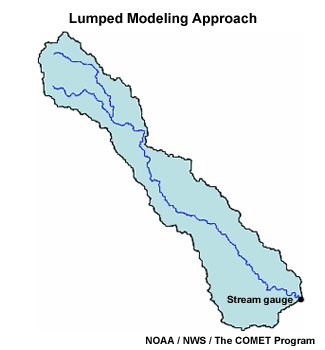
The most basic approach for more complex modeling of runoff from a basin is called the "lumped"� method. This type of hydrologic model views a particular drainage area as a single unit and uses basin-averaged hydrologic and meteorological inputs. The output from a lumped model is usually a hydrograph at the basin outlet.
One example of a lumped model currently in use in the United States is the Sacramento Soil Moisture Accounting model called SACSMA, which is a spatially lumped continuous accounting model. This continuous model uses mean basin precipitation, evaporation, temperature, basin topography, and soil characteristics as inputs. Outputs include direct runoff, surface runoff, baseflow, interflow, and evapotranspiration.
Continuous means that the model variables that account for soil moisture are updated on a day-to-day basis. This allows for creation of an ongoing model condition of soil moisture.
The SACSMA model is ideally suited for the simulation of large drainage basins – greater than 1,000 square kilometers. Because the model simulates storm runoff as well as baseflow, it is also useful for water supply estimates. Additional inputs to this model include the location of important features such as reservoirs, lakes, and river junctions.
In the past, lumped modeling methods were required due to data collection methods and software limitations. Lumped models are still useful for producing flood guidance. They require less data input and less computational power than more modern methods. However, as new geo-spatial technologies become available, lumped models are being replaced by methods using more detailed spatial information to examine the basin on a finer scale.
Semi-Distributed Modeling
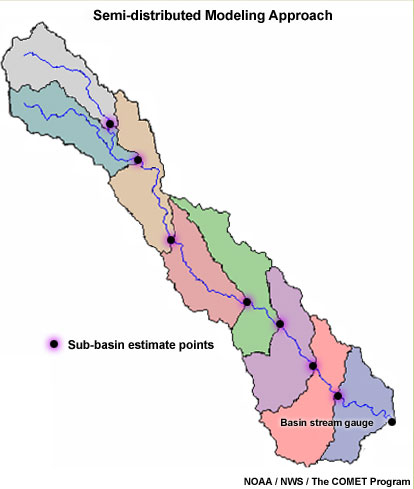
Semi-distributed modeling is a variation of the lumped method and is sometimes referred to as a "pseudo-distributed"� approach. Using this approach, a basin is broken down into smaller sub-basins. Runoff amounts from methods such as unit hydrograph are used to estimate streamflow from each of these sub-basins. These runoff volumes are then routed downstream to estimate the streamflow output for the larger basin at the outlet.
The Unified River Basin Simulator, or URBS, is a popular semi-distributed rainfall-runoff-routing model currently in use across much of Australia and has been used for the Mekong river valley as well as various research efforts worldwide. Derived and assumed model parameters are set at the sub-basin level and flows are based on center-of-mass weighted inflows. URBS can be used as an event-based model that requires the user to input the rainfall lost to the basin or sub-basin before the runoff occurs, or it may be run in a continuous mode and coupled to other third-party runoff loss models. Please consult http://members.optusnet.com.au/~doncarroll/downloads.htm to explore more about the URBS model.
The HBV model from the Swedish Meteorological and Hydrological Institute is another popular continuous model that may be run as lumped or semi-distributed. It has been used for a wide variety of research efforts across the globe, and may be used for flood forecasting, design flood simulations and nutrient estimation. Please consult http://www.smhi.se/forskning/forskningsomraden/hydrologi/hbv-1.1566 for more information on HBV.
Distributed Modeling

A truly distributed modeling approach is one that represents processes via high-resolution, distinct model elements. This can be performed in a gridded manner, or through smaller sub-basins, flowplanes, triangulated irregular networks, or hydrologic response units. This approach provides for detailed predictions at many points across a basin. For simplicity, we will examine the distributed modeling concept with the grid-cell approach here.
With this type of approach, each cell has parameters allowing for its own streamflow estimates. The flow at any grid point can be estimated mathematically. One drawback to distributed modeling is the additional input data required for each cell. If these data are not available, they must somehow be estimated, introducing an uncertainty factor.

Above, we have gridded precipitation and surface runoff data for a basin. Very little rain fell on the upper part of the basin. There is no runoff response at point A. Small amounts of rain fell in the middle of the basin, so the runoff does show a small response at point B.
The heaviest rain fell in the lower part of the basin resulting in a significant and rapid peak flow at point C.
A lumped simulation for this basin would only show the averaged effects over the whole basin. It would underestimate the peak amount for point C, and the timing at point C would be inaccurately delayed.
The distributed model, however, is able to capture the spatial variability of the precipitation and produce a more reasonable simulation at point C as well as flow estimates at points A and B.

In this image we see the downstream flow vectors for each cell. Physics-based parameters and equations are used to route flows from cell to cell to the outlet.
Keep in mind that this represents an estimate of the flow path. We see that some parts of the basin are left out in the conversion to the grid representation. At the same time, other areas that actually lie outside of the basin are included in the gridded area.
The former Danish Hydraulic Institute, an international non-profit consulting group operating as DHI, has developed a suite of models that simulate many hydrologic processes, depending on need. MIKE 11, the rainfall-runoff model, may be run at several stages of complexity, depending on need and available data. It may be run in a lumped mode that simulates only overland, inter- and base flows or it may be run up to a fully-distributed mode that simulates runoff, hydrologically and hydraulically routed streamflows and other processes such as river-aquifer exchange. There are intermediate rainfall-runoff modes which include an event-based package, as well as a soil moisture accounting mode and a semi-distributed mode. These and various other water modeling resources from DHI are popular around the globe in both research and operational forecasting efforts. For more information, please see DHI’s website: http://www.mikebydhi.com
Distributed hydrologic models are becoming more popular and spatially complex as technologies such as Doppler radar, Global Positioning System (GPS), and Geographic Information Systems (GIS) are becoming more widespread in the creation of geo-referenced, gridded datasets.
Review Questions
Question 1
Lumped models cannot account for details in the rainfall distribution and basin topographic features. (True or False.)
The correct answer is a.
Question 2
Compared to lumped models, distributed models _____. (Choose all that apply.)
The correct answers are a and d.
Question 3
Semi-distributed models may provide more detail about potential runoff than lumped models by _____. (Choose the best answer.)
The correct answer is c.
Question 4
The Rational Method for estimating runoff uses a land use coefficient, C, which would be ____ for a shopping mall than for a patch of woodland. (Choose the best answer.)
The correct answer is a.
Summary
Overview of Runoff
- Runoff is often defined as the portion of rain, snowmelt, and irrigation water that moves toward the stream channel rather than infiltrating the soil.
- For some purposes, however, runoff also includes the subsurface water known as interflow which also quickly moves toward the stream channel.
- Runoff is the most important component of flood prediction.
- The three soil water processes are:
- The entry or infiltration of water into the soil
- The transmission of water within the soil
- The storage of water as soil water
- Important runoff terms include:
- Basin – the area that drains to a single outlet point
- Baseflow – the long-term supply that keeps water flowing in streams
- Infiltration – the downward movement of water through the soil surface
- Percolation – the movement of water within the soil profile
- Surface runoff – the movement of water across the soil surface to the stream channel
- Interflow – the relatively rapid movement of water beneath the soil surface to the stream channel
- Runoff – sometimes this is just the surface runoff, but it can refer to a combination of surface runoff and interflow.
- Infiltration rate – the amount of water able to enter the soil in a specified time
- Infiltration capacity – the upper limit of the infiltration rate
- Surface runoff equals the rainfall or snowmelt rate minus the infiltration capacity.
Paths to Runoff
- There are two types of surface runoff:
- Infiltration excess overland flow (Hortonian flow)
- Saturation excess overland flow
- Infiltration excess overland flow occurs when the rainfall rate exceeds the infiltration capacity and can occur even in dry soil conditions.
- Saturation excess overland flow occurs when the soil is saturated and no more rain or snowmelt can infiltrate.
- Interflow is the subsurface movement of water to the stream and can be a significant component of runoff.
- Transmissivity feedback occurs where macropores are activated by interflow.
- Macropores are natural voids and pipes in the soil that increase interflow and are formed by biological and chemical activity.
- Enhanced interflow may occur along a soil-bedrock interface, especially if the bedrock is sloped.
- A fragipan is an area of relatively low permeable soil and rock that can block the downward percolation of water and increase horizontal water movement.
- Groundwater ridging occurs when surface rain or snowmelt reaches the water table more easily in a given area causing the water table to bulge upward – this can increase interflow.
- Pre-event water is water that exists in the soil profile when a storm begins and gets displaced into the stream by newly infiltrated water. It can be a very important contributor to runoff as interflow.
Basin Properties
- With uniform basin characteristics and coverage of rainfall or snowmelt, larger basins result in a larger volume of runoff.
- Uniform coverage is unusual, so runoff is determined by the part of the basin that receives the rainfall; this is known as the contributing area.
- For basins of equal area but different shapes, a long narrow basin will result in a hydrograph that has a lower peak flow and is spread out over a longer time when compared with a "rounder"� basin.
- When compared to a meandering stream, a straight stream will result in a stream response that is faster and has a higher peak flow.
- When compared to a relatively flat basin, a steeply sloped basin will result in a stream response that is faster and has a higher peak flow.
- When compared to a stream channel with rough surfaces (lots of rocks and vegetation), a smooth stream channel will result in a stream response that is faster and has a higher peak flow.
- Stream density is the length of all the channels in a basin divided by the basin area.
- High stream density indicates a basin with numerous tributaries and faster, more efficient runoff.
- Urbanization results in increases in both the amount and the speed of runoff.
Soil Properties
- Soil texture is important for anticipating infiltration and storage of water and is determined by the diameter of the soil particles.
- Clay has the smallest soil particle diameter, followed by silt, and then sand with the largest particles.
- Sandy soil allows water to infiltrate and drain more quickly than clay soil.
- Clay soil can hold a larger volume of water than sandy soil, but runoff during intense rainfall is more likely with clay due to its lower infiltration rate. Clay also stays saturated longer than sand.
- Depth to impermeable layers such as bedrock or a fragipan can influence how much water the soil layer can hold and how quickly it will saturate.
- Shallow soils typically saturate more quickly.
- Surface characteristics are very important for determining the potential for rapid surface runoff.
- Urbanization – impermeable and compacted surfaces increase the amount and speed of runoff
- Deforestation and forest fires – removal of vegetation and burning of the soil can increase the amount and speed of runoff as well as the sediment loading in the runoff, especially in sloped areas due to the loss of vegetation and the decrease in infiltration
Modeling Concepts
- The Rational Method is a simple runoff model that takes into account land use characteristics for small basins using a land-use runoff coefficient, or "C" value.
- C values vary from near zero in rural or forested areas to almost 1.0 in urban areas and parking lots.
- Lumped models are relatively simple in that the basin is treated as a single unit
- Basin-averaged hydrologic and meteorological inputs are used
- A semi-distributed or pseudo-distributed model breaks the basin down into a collection of smaller sub-basins than the lumped-model approach
- Distributed models represent details of the hydrologic and meteorological characteristics by representing basins with a grid.
- The distributed modeling approach is:
- Much better at representing variability in hydrologic response within the basin
- More realistic for flash flood modeling
- More computationally intensive than lumped modeling



